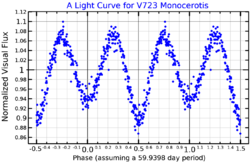Astronomy:V723 Monocerotis
| Observation data Equinox J2000.0]] (ICRS) | |
|---|---|
| Constellation | Monoceros |
| Right ascension | 06h 29m 04.659s[2] |
| Declination | −05° 34′ 20.23″[2] |
| Apparent magnitude (V) | 8.21 - 8.42[3] |
| Characteristics | |
| Spectral type | G0II[4] |
| Variable type | Ellipsoidal[5] |
| Astrometry | |
| Proper motion (μ) | RA: −1.347[2] mas/yr Dec.: 16.140[2] mas/yr |
| Parallax (π) | 2.1748 ± 0.0331[2] mas |
| Distance | 1,500 ± 20 ly (460 ± 7 pc) |
| Absolute magnitude (MV) | +0.93[6] |
| Orbit[1] | |
| Period (P) | 59.9398 d |
| Eccentricity (e) | 0 (fixed) |
| Inclination (i) | 87.0+1.7 −1.4° |
| Argument of periastron (ω) (secondary) | 0 (fixed)° |
| Details | |
| Giant star | |
| Mass | 0.44±0.06[5] M☉ |
| Radius | 22.5±1.0[5] R☉ |
| Luminosity | 173±8[1] L☉ |
| Surface gravity (log g) | 1.7±0.1[1] cgs |
| Temperature | 3,800±100[5] K |
| Metallicity [Fe/H] | −0.9±0.1[1] dex |
| Rotational velocity (v sin i) | 15±2[5] km/s |
| Age | 5.4+5.1 −2.6[1] Gyr |
| Stripped subgiant | |
| Mass | 2.8±0.3[5] M☉ |
| Radius | 8.3±0.4[5] R☉ |
| Temperature | 5,800±200[5] K |
| Rotational velocity (v sin i) | 70±10[5] km/s |
| Other designations | |
| Database references | |
| SIMBAD | data |
V723 Monocerotis is a variable star in the constellation Monoceros. It was proposed in 2021 to be a binary system including a lower mass gap black hole candidate nicknamed "The Unicorn".[1] Located 1,500 light years from Earth, it would be the closest black hole to our planet, and among the smallest ever found.[8][9]
Located in the Monoceros constellation, V723 Monocerotis is an eighth-magnitude ellipsoidal variable yellow giant star roughly the mass of the Sun, but 25 times its radius. The accompanying black hole was proposed to have a mass 3 times the mass of the Sun, corresponding to a Schwarzschild radius of 9 kilometers.[10][11]
Follow-up work in 2022 argued that V723 Monocerotis does not contain a black hole, but is a mass-transfer binary containing a red giant and a subgiant star that has been stripped of much of its mass.[5]
See also
References
- ↑ 1.0 1.1 1.2 1.3 1.4 1.5 1.6 Jayasinghe, T. et al. (2021-01-01). "A unicorn in monoceros: The 3 M⊙ dark companion to the bright, nearby red giant V723 Mon is a non-interacting, mass-gap black hole candidate". Monthly Notices of the Royal Astronomical Society 504 (2): 2577–2602. doi:10.1093/mnras/stab907. Bibcode: 2021MNRAS.504.2577J.
- ↑ 2.0 2.1 2.2 2.3 Brown, A. G. A. (2021). "Gaia Early Data Release 3: Summary of the contents and survey properties". Astronomy & Astrophysics 649: A1. doi:10.1051/0004-6361/202039657. Bibcode: 2021A&A...649A...1G. Gaia EDR3 record for this source at VizieR.
- ↑ "V723 Mon". https://www.aavso.org/vsx/index.php?view=detail.top&oid=19551.
- ↑ Houk, N.; Swift, C. (1999), "Michigan catalogue of two-dimensional spectral types for the HD Stars", Michigan Spectral Survey 5, Bibcode: 1999MSS...C05....0H.
- ↑ 5.0 5.1 5.2 5.3 5.4 5.5 5.6 5.7 5.8 5.9 El-Badry, Kareem; Seeburger, Rhys; Jayasinghe, Tharindu; Rix, Hans-Walter; Almada, Silvia; Conroy, Charlie; Price-Whelan, Adrian M.; Burdge, Kevin (2022). "Unicorns and giraffes in the binary zoo: Stripped giants with subgiant companions". Monthly Notices of the Royal Astronomical Society 512 (4): 5620–5641. doi:10.1093/mnras/stac815. Bibcode: 2022MNRAS.512.5620E.
- ↑ Strassmeier, K.; Washuettl, A.; Granzer, Th.; Scheck, M.; Weber, M. (2000). "The Vienna-KPNO search for Doppler-imaging candidate stars. I. A catalog of stellar-activity indicators for 1058 late-type Hipparcos stars". Astronomy and Astrophysics Supplement Series 142 (2): 275. doi:10.1051/aas:2000328. Bibcode: 2000A&AS..142..275S.
- ↑ "V723 Mon". SIMBAD. Centre de données astronomiques de Strasbourg. http://simbad.u-strasbg.fr/simbad/sim-basic?Ident=V723+Mon.
- ↑ "Newfound black hole may be the closest to Earth" (in en). 2021-04-29. https://www.nationalgeographic.com/science/article/newfound-black-hole-may-be-the-closest-to-earth.
- ↑ "A black hole dubbed 'the Unicorn' may be galaxy's smallest one". 2021-04-22. https://www.reuters.com/lifestyle/science/black-hole-dubbed-the-unicorn-may-be-galaxys-smallest-one-2021-04-22/.
- ↑ "Is the "Unicorn" the Closest Black Hole?" (in en-US). 2021-04-23. https://skyandtelescope.org/astronomy-news/unicorn-closest-black-hole/.
- ↑ "Where is the nearest black hole to Earth?" (in en). https://www.skyatnightmagazine.com/space-science/where-is-nearest-black-hole/.
Further reading
- Masuda, Kento; Hirano, Teruyuki (April 2021). "Tidal Effects on the Radial Velocities of V723 Mon: Additional Evidence for a Dark 3 M⊙ Companion". The Astrophysical Journal Letters 910 (2): 10. doi:10.3847/2041-8213/abecdc. L17. Bibcode: 2021ApJ...910L..17M.
 |


